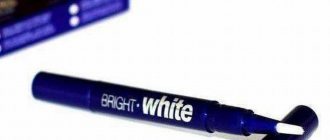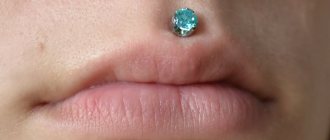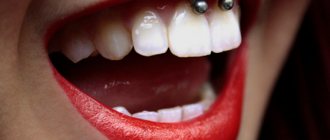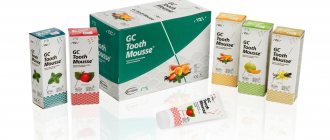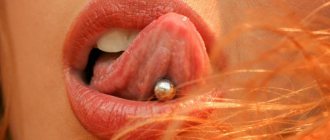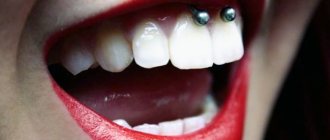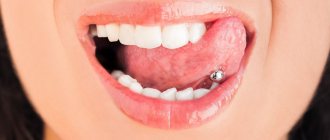Today, oral piercing is extremely popular all over the world. The demand for piercing services is not small in St. Petersburg either. Most piercing fans are young people and teenagers who are trying to look “worthy” compared to their peers. Meanwhile, most people, when getting cheek, lip and tongue piercings, do not think at all about how wearing hard metal objects in the mouth can further affect the condition of the teeth and gums.
If we consider piercing from a dental point of view, then this procedure carries a great danger both for the oral cavity and for the body as a whole. A foreign body in the mouth can cause infections, plus the risk of mechanical damage to the teeth and gums increases significantly. Tongue piercing causes prolonged bleeding, since mechanical damage to the tongue takes a very long time to heal. The result is a temporary disturbance in speech and chewing functions.
Do dentists approve of piercings? Answer: NO!
Initial risks
Anyone who wants to have a tongue or lip piercing needs to understand that after creating a puncture, a wound surface is formed, which requires careful care. It must be remembered that the mouth is an ideal environment for the proliferation of pathogenic bacteria (humidity, temperature, small pieces of food and plaque). Therefore, the wound can take a very long time to heal. Even without hygiene and asepsis, there is a high probability of infection and the development of purulent-inflammatory processes that can spread to nearby tissues.
Important ! An infection can be acquired by having an oral piercing performed by an unscrupulous specialist who violates the rules of asepsis and uses a poorly processed instrument. And we’re not just talking about suppuration of tissues, accompanied by redness, pain, discharge of pus, bad breath, deterioration in general well-being and high fever. This way you can become infected with HIV, hepatitis B and C.
It is important to note that during the first 3-5 days after the puncture, the tissues swell, turn red, may bleed, and become very sensitive. The tongue may increase in size, which negatively affects the pronunciation of sounds, chewing and swallowing food. Painful reactions occur to hot and cold, spicy and sour foods, as well as simply when moving a muscle organ.
If the specialist has insufficient experience, during the puncture you may encounter severe tissue trauma, after which it will take a long time to heal and become scarred, that is, an unsightly scar will remain on them. But that's not all the consequences. It is much more unpleasant and dangerous if the puncture ends in damage to blood vessels and nerves, the development of neuralgia, and disruption of the motor activity of a muscle organ.
Lip healing time
The minimum healing time for a lip piercing is 2 weeks. During this time, the wound heals and dries out, and after a month it heals completely. If the entire process went without complications, then after the specified period has passed, you can begin to periodically remove the jewelry.
But not longer than a day, otherwise the hole may heal. You can also change the decoration to something more attractive.
It is recommended to remove the earring for a few days only a year after piercing.
How bad is it for teeth?
If you get a tongue piercing, will it damage your teeth? Yes, premature destruction of enamel and dentin is more than real, because the earring located in the mouth constantly has a mechanical effect on the surrounding tissues. Owners of fashion accessories often have the following problems:
- the appearance of cracks and chips on the enamel: the front units of the row suffer the most, because they bear the main “blow”,
- increased sensitivity and abrasion of hard tissues,
- the risk of developing caries and other dental pathologies increases.
Expert opinion
Elina Ruslanovna Dzagurova
Specializations: Dentist-therapist
Experience: 10+
“If there is a piercing in the mouth, then various restorations carried out in the smile area in order to improve aesthetics serve less. Especially with ceramic, composite or plastic coating. Decoration damages their surface, leaving scratches and cracks as easily as on the surface of natural teeth.”
Standard types of piercing
There is a large selection of methods and places for lip piercing:
- "Monroe" and "Madonna" - piercing of the upper lip. In the first case, the piercing is done on the left side, in the second - on the right. The piercings are named after Marilyn Monroe and Madonna and symbolize the birthmarks of these famous women. This option is more common among girls.
- “Medusa” - pierce the central part of the nasolabial fold. The safest place.
- "Jestrum" is a complex type of piercing. The needle goes directly through the pink part. The decoration on the outside is located in two places: in the middle of the upper lip and on its border with the nasolabial fold.
- “Antismile” and “Smile” are punctures of the frenulum under the lower and upper lip, respectively. The first option is visible only when you open your mouth, and the second - when you smile. Not the most convenient way - decoration interferes with eating and damages teeth.
- Labret is a piercing under the lower lip. The needle passes through the mouth. This hole heals quickly.
- “Horizontal labret” - piercing of the lower lip in the pink part. The decoration with two free ends is located outside in a horizontal plane. With this type of puncture, the earring often does not take root.
- “Vertical labret” is the same “Jestrum”, only with the lower lip. It takes a long time to heal and is painful.
- "Ashley" - piercing of the central part of the lower lip. The needle goes right through, like in Medusa.
What will happen to the gums
In people with tongue or lip piercings, a factor is constantly present in the mouth, leading to an increased accumulation of plaque and the dominance of bacteria - and this, in turn, provokes inflammatory processes in the mucous membranes and can cause stomatitis, gingivitis and periodontitis. It is also important to emphasize that the habit of “playing” with fashionable jewelry and moving it back and forth in the mouth can cause not only injuries to the teeth and their roots (especially in the lower jaw), but also severely rub the tissue, cause damage to the mucous membrane, lead to bleeding, the formation of ulcers, erosions and aphthae.
On a note ! According to research, wearing a piercing in the mouth is one of the factors that can lead to gum recession, exposure of tooth roots, as well as displacement, loosening and premature loss of the latter.
Types of skyes
New technologies, a variety of materials and fashion trends suggest that dental piercings can be performed using a variety of skypes. They differ in the material from which they are made:
- from precious stones, most often diamonds;
- made of crystal or Swarovski crystals;
- made of rhinestones or glass;
- made of gold or medical alloys, so-called twinkles
The shape of metal skyes can be very diverse - round, oval, in the form of various figures, as well as different colors. The diamond is usually set in a round shape no more than two millimeters in diameter. A tooth skyce can consist of one element, or it can be combined.
Consequences of wearing piercings for the oral cavity in general
Tongue or lip piercing means a permanent hole in the mouth through which harmful microorganisms can circulate. Hard-to-remove food particles can get inside it and onto the earring itself (rings, rods), which gradually rot. Accordingly, bacterial plaque accumulates in this area, provoking various inflammatory processes. Increased plaque accumulation leads to persistent bad breath.
The presence of a ring in the mouth is perceived by the body as a “foreign object,” which causes significant discomfort, especially at the adaptation stage. During a conversation and even chewing food, the jewelry constantly comes into contact with the mucous membranes and causes microtrauma to the delicate tissues.
Piercing in the mouth can have different consequences
Piercing can lead to difficulties with proper chewing of food and impaired diction. Many people experience increased salivation. Some, on the contrary, are concerned about severe dryness and the development of xerostomia. In clinical practice, there are cases when the sensitivity of the punctured muscle organ completely disappears, and as a plus, the taste of food is distorted.
There are also a number of unpleasant, but few expected consequences - allergies, the development of glossitis and even galvanic syndrome. As a rule, jewelry is created from base metals, which tend to gradually oxidize under the influence of the oral environment. As a result, the following reactions are possible: the constant presence of a metallic taste in the mouth, soreness of the muscle organ, swelling, itching and irritation of the mucous membrane, the appearance of a rash (bubbles, pimples, ulcers). As for galvanism, it can develop in people who, in addition to metal piercings, have crowns, dentures and braces in their mouths, which also contain metal.
On a note ! For piercing, barbells or studs are usually used - earrings consisting of a straight rod and several twists (fixing elements). Carefully ensure that the system elements are tightly connected to each other and tighten them periodically. Otherwise, there is a risk of individual elements unwinding, swallowing them, and even suffocation.
New trends: punctures - “bites”
In addition to the classic piercing options, there are more exotic ones - “bites”. Such holes are made symmetrically in at least 2 places.
There are the following types of “bites”:
- “Angela” – 2 through punctures above the upper lip on opposite sides.
- “Dogs” – to the previous 2, a pair of the same punctures are added under the lower lip.
- “Snakes” – 2 through holes under the lower lip, as in “Dog Bite”.
- "Kibera" - combines the classic "Medusa" and "Labret".
- "Dahlia" - piercing in the corners of the mouth.
- “Dolphin” – 2 adjacent punctures under the lip from below and – a pair of holes under the lower lip on the side.
- "Sharks" is a two-sided "Spider".
The most popular of all is considered to be the “snake bite”. It is also less painful. The rarest ones are “dogs” and “sharks”.
Often, “bites” are made gradually: first one hole, and after it has completely healed, another.
How to minimize unpleasant consequences for the oral cavity
1. Prepare thoroughly for the puncture procedure
To do this, be sure to have your oral cavity sanitized by a dentist, which will include removing all types of bacterial plaque using a professional hygiene complex, as well as treating diseased teeth and gums. This measure will help reduce the risk of developing purulent-infectious processes in a fresh wound left after puncture of tissues communicating with the oral cavity (during lip piercing). Immediately before the procedure, thoroughly brush your teeth and rinse your mouth with an antiseptic.
Important ! Contraindications to the procedure: diseases of the mucous membrane and periodontal tissues, epilepsy, mental disorders, poor blood clotting, diabetes, hemophilia. It is not recommended for women during menstruation or pregnancy.
Find a good specialist
You should not carry out the puncture procedure yourself or with private specialists who do not have the appropriate license. It is better to find a salon where certified professionals work and all aseptic rules are followed.
Choose a specialist wisely
“I wanted to make myself a ring on the very tip of my tongue, but I came across a very good one. a good master, who explained all the disadvantages, dissuaded me. He said that asymmetrical punctures, i.e. not in the center of the tongue, they take a very long time to heal. Plus there is a very high risk of damaging the arteries and capillaries, and this can result in stitches and the inability to wear the piercing at all. It also turns out that then all the enamel gets knocked off the teeth very quickly. I didn’t even suspect such complications.”
Mara, review from 32top.ru
3. Choose jewelry made from biocompatible metals
To reduce the risk of developing allergies, give preference to materials such as gold, silver, and titanium. If these are base metals, then they should not contain nickel, which causes negative reactions in the body in a large number of people.
4. Follow some rules during the tissue healing stage
In order for the tissues to heal faster after a tongue piercing, and for you to experience less pain, you should initially avoid eating cold, hard, hot and spicy foods. It is better to give preference to products with a soft consistency. Avoid alcohol, smoking, taking blood thinning medications, chewing tobacco and gum, and chewing seeds and candies. Do not pull or play with the jewelry to help the wound heal faster. Do not put dirty hands or objects into your mouth. Talk less.
Rinse your mouth with any suitable antiseptic - Chlorhexidine, Miramistin, Furacilin. A mouthwash containing chlorhexidine is also suitable. Rinse should be done in the morning and evening, after meals. But no more than 3-4 times a day and no longer than 7-10 days in a row. But the use of more aggressive compounds for the purpose of tissue antiseptics - hydrogen peroxide, alcohol, manganese, iodine - should be abandoned so as not to cause burns and additional irritation.
Thorough rinsing is the key to hygiene
Interesting ! The average length of permanent tongue decorations is 10-15 mm. But at the initial stage, craftsmen use longer temporary rods - about 19 mm. After all, after a puncture, the tongue swells greatly. However, these can quickly chip the enamel, so after 3-4 weeks it is recommended to contact a specialist to replace them with shorter ones. 6 months after the puncture, you can change the bar yourself, but you cannot choose one that is too short, on which the clamps will be located end-to-end, because when talking and moving, the tongue constantly changes its shape. A short length can contribute to additional discomfort, tissue injury, and increased plaque accumulation.
Pain during the procedure
The degree of pain depends on the place chosen for the piercing and the mood. Experts recommend holding your breath during the puncture and thinking about something positive.
A piercing of the upper lip is the most unpleasant. Piercing the pink part of the lips also falls into this category. A piercing of the lower lip is less painful.
To reduce pain after the procedure, it is recommended to rinse your mouth with disinfectants more often and not touch the earring. Depending on the degree of pain tolerance, discomfort can last from several days to one and a half months.
